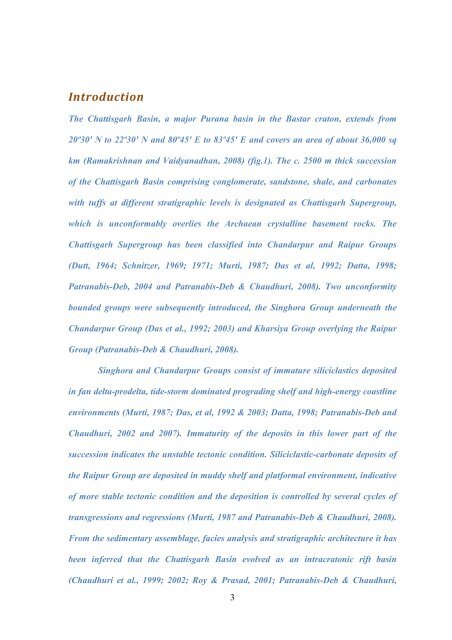of the Singhora-Saraipali area, south-eastern Chattisgarh Basin - fieldi
of the Singhora-Saraipali area, south-eastern Chattisgarh Basin - fieldi
of the Singhora-Saraipali area, south-eastern Chattisgarh Basin - fieldi
Create successful ePaper yourself
Turn your PDF publications into a flip-book with our unique Google optimized e-Paper software.
Introduction<br />
The <strong>Chattisgarh</strong> <strong>Basin</strong>, a major Purana basin in <strong>the</strong> Bastar craton, extends from<br />
20º30' N to 22º30' N and 80º45' E to 83º45' E and covers an <strong>area</strong> <strong>of</strong> about 36,000 sq<br />
km (Ramakrishnan and Vaidyanadhan, 2008) (fig.1). The c. 2500 m thick succession<br />
<strong>of</strong> <strong>the</strong> <strong>Chattisgarh</strong> <strong>Basin</strong> comprising conglomerate, sandstone, shale, and carbonates<br />
with tuffs at different stratigraphic levels is designated as <strong>Chattisgarh</strong> Supergroup,<br />
which is unconformably overlies <strong>the</strong> Archaean crystalline basement rocks. The<br />
<strong>Chattisgarh</strong> Supergroup has been classified into Chandarpur and Raipur Groups<br />
(Dutt, 1964; Schnitzer, 1969; 1971; Murti, 1987; Das et al, 1992; Datta, 1998;<br />
Patranabis-Deb, 2004 and Patranabis-Deb & Chaudhuri, 2008). Two unconformity<br />
bounded groups were subsequently introduced, <strong>the</strong> <strong>Singhora</strong> Group underneath <strong>the</strong><br />
Chandarpur Group (Das et al., 1992; 2003) and Kharsiya Group overlying <strong>the</strong> Raipur<br />
Group (Patranabis-Deb & Chaudhuri, 2008).<br />
<strong>Singhora</strong> and Chandarpur Groups consist <strong>of</strong> immature siliciclastics deposited<br />
in fan delta-prodelta, tide-storm dominated prograding shelf and high-energy coastline<br />
environments (Murti, 1987; Das, et al, 1992 & 2003; Datta, 1998; Patranabis-Deb and<br />
Chaudhuri, 2002 and 2007). Immaturity <strong>of</strong> <strong>the</strong> deposits in this lower part <strong>of</strong> <strong>the</strong><br />
succession indicates <strong>the</strong> unstable tectonic condition. Siliciclastic-carbonate deposits <strong>of</strong><br />
<strong>the</strong> Raipur Group are deposited in muddy shelf and platformal environment, indicative<br />
<strong>of</strong> more stable tectonic condition and <strong>the</strong> deposition is controlled by several cycles <strong>of</strong><br />
transgressions and regressions (Murti, 1987 and Patranabis-Deb & Chaudhuri, 2008).<br />
From <strong>the</strong> sedimentary assemblage, facies analysis and stratigraphic architecture it has<br />
been inferred that <strong>the</strong> <strong>Chattisgarh</strong> <strong>Basin</strong> evolved as an intracratonic rift basin<br />
(Chaudhuri et al., 1999; 2002; Roy & Prasad, 2001; Patranabis-Deb & Chaudhuri,<br />
3









